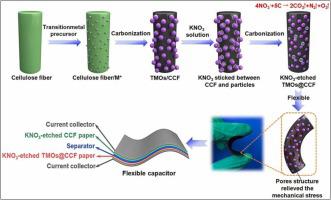Industrial Crops and Products ( IF 5.6 ) Pub Date : 2023-05-19 , DOI: 10.1016/j.indcrop.2023.116894 Yu Shi , Yuren Liu , Jiyuan Zhang , Xiujie Huang , Xueren Qian

|
Cellulose paper is considered to be a promising substrate of energy materials for energy storage device due to its flexible, porous, renewable, degradable, and environmental-friendly feature. However, the large weight and low conductivity of cellulose fibers limit the specific capacitance and energy density of the paper electrodes. Converting cellulose fibers into conductive carbon fibers (CCF) by high temperature carbonization is an effective strategy for improving the electrochemical performance of paper electrodes. But the brittleness of carbonized paper limits its application in flexible supercapacitors. In addition, stable loading of energy materials on CCF is another challenge. Here, KNO3 in-situ etching activation method is used to construct the embedded structure of transition-metal oxides (TMOs) on CCF. And the embedding degree of TMOs on CCF can be adjusted by controlling the amount of KNO3. The embedded structure releases the mechanical stress from bending of CCF, endowing good flexibility for carbonized paper. In addition, embedded structure can anchor TMOs into CCF, and increase the porosity and specific surface area of CCF, promoting a rapid ion diffusion and electron transport for high capacitance contributions. The KNO3-etched Co3O4@CCF paper as an electrode exhibits a high volume specific capacitance of 72.3 F cm−3 at current density of 0.5 mA cm−2 (more than three times higher than that of Co3O4/CCF paper) and shows good rate capability (capacitance retention of 83.3% with 10 times current density) and long lifetime (charge-discharge stability of 94.8% after 10000 cycles). Even in bending state, the composite paper still maintains stable electrochemical performances, which can broaden potential application in flexible supercapacitors.
中文翻译:

对具有嵌入碳化纤维素纤维的过渡金属氧化物的柔性碳化纸支撑电极的原位蚀刻活化
纤维素纸具有柔韧、多孔、可再生、可降解、环保等特点,被认为是一种很有前途的储能装置能源材料基材。然而,纤维素纤维的大重量和低电导率限制了纸电极的比电容和能量密度。通过高温碳化将纤维素纤维转化为导电碳纤维(CCF)是提高纸电极电化学性能的有效策略。但碳化纸的脆性限制了其在柔性超级电容器中的应用。此外,在CCF上稳定加载能源材料是另一个挑战。在这里,硝酸钾3采用原位刻蚀活化法在 CCF 上构建过渡金属氧化物 (TMO) 的嵌入结构。并且可以通过控制KNO 3的用量来调节TMOs在CCF上的包埋程度。嵌入式结构释放了CCF弯曲产生的机械应力,赋予碳化纸良好的柔韧性。此外,嵌入式结构可以将 TMO 锚定到 CCF 中,并增加 CCF 的孔隙率和比表面积,促进快速离子扩散和电子传输以获得高电容贡献。KNO 3蚀刻的Co 3 O 4 @CCF纸作为电极在0.5 mA cm -2的电流密度下表现出72.3 F cm -3的高体积比电容(比 Co 3 O 4 /CCF 纸高 3 倍以上)并表现出良好的倍率性能(10 倍电流密度下的电容保持率为 83.3%)和长寿命(10000 次循环后充放电稳定性为 94.8%)。即使在弯曲状态下,复合纸仍保持稳定的电化学性能,这可以拓宽在柔性超级电容器中的潜在应用。











































 京公网安备 11010802027423号
京公网安备 11010802027423号